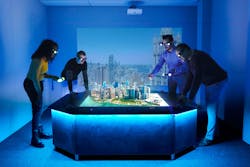Tekle Holographics, the company that builds software for real-time holographic images, will demonstrate its first step towards the metaverse at CES 2022. Its holographic solution can create a real lifelike 3D experience for the metaverse. Users can participate in this immersive setup without a headset.
“Holographic” technology is already available in different forms, but it is expensive, time consuming and often inaccurate. Tekle Holographics addresses these issues with the introduction of its cross-platform Holographics solution and the world’s first holograms that actually float in mid-air. 3D data can be quickly and accurately converted to holographics and at low costs. This makes the metaverse possible today in a never-before-seen social immersive way. For applications that need AR or VR, these holographic images can also be converted to augmented or virtual reality.
Michel Tzsfaldet, CEO Tekle Holographics: “While everyone in the tech world is philosophizing about the metaverse, we already have the platform to make the metaverse possible right now. We have created a virtual shared space by an interplay of AR, VR, holograms and 5G”.
More than a game
But Tekle’s holographic solutions offer more than just a way to play games. Technical pilots and use cases already show their value in business applications. The use of holographic technology in business offers unlimited possibilities.
Holograms have many advantages over AR and VR. For example, users do not need headsets, which improves interaction while studying the holographic object. Normally, it can take up to 72 hours to download large amounts of data and convert them into a 3D image. With the application of Tekle Holographics, this time has been reduced to 20 minutes, which is 216 times faster and amounts to a time saving of over 99.5%!
Ultra-fast calculations
The technology can quickly visualize complex multibody dynamics calculations. Think of images that can be used in research on the human body, robotics, and other mechanical systems. Rendering with the application of Tekle Holographics not only saves time but also requires substantially less energy to perform calculations.
One of the great applications of Tekle Holographic is the possibility to create a digital twin in full immersive 3D. Given the right data from specific sources like building information, geographic information systems and point cloud scans, enhanced with data from IoT-sensors, Tekle Holographics can create a 3D holographic model of a city for example, that can be viewed from all sides and interacted with.
For medical applications, MRI scans can be converted to a hologram. This allows for easy detection of flaws in the patient’s body. A doctor can draw up very detailed operation plans, changing surgeries from one size fits all to a patient specific treatment.
Other features of Tekle Holographics holography technology include:
- The costs of creating holograms drop with 90% when using Tekle Holographics. This means that the technology is within reach of any company and for any industry. Return on investment is quickly achieved.
- Tekle Holographics solution can process any amount of data in real time from sources such as Autodesk, GIS, BIM, and point cloud scans, and many others.
- Thanks to its cross-platform capabilities, all holographic solutions can also be seen through AR or VR, converting without the loss of data.
- Users who are not able to participate in the holographic session can still be involved using their own device of choice. They won’t see the 3D holographic but they can see the image on their computer, tablet, etc.
Different ways of visualizing holograms
Tekle Holographics has several devices for visualizing its holograms:
- The Holo-Room is a 4x5m fully immersive room suitable for lifesize experiences and realistic simulations.
- The Holo-Table is a 2x2m device, that provides a bird’s eye view of realistic 3D data. It’s best for visualizing landscapes and tracking real time developments, like a holographic image of a building, or a digital twin of a city.
- The Holo-Wall creates a 2x3.5m screen which visualizes 3D information and acts as an interface between the real and virtual worlds. Holograms can come out up to 4m. Projections can be either interactive or stand-alone animations. Ideal for presenting car models, for example, but also for museums to display depot pieces or for educational projects.
- The portable Holo-Wall is a portable version of the Holo-Wall that fits into two suitcases and can be set-up within 10 minutes.
Request More Information
Latest in CES Show






